Today is World Communication Design Day…
And of course it’s a day that I can’t help but think of our dear, recently-departed friend and colleague… Guy A. Schockaert.
Competition stimulates, cooperation reinforces, and solidarity unites.

And of course it’s a day that I can’t help but think of our dear, recently-departed friend and colleague… Guy A. Schockaert.
Competition stimulates, cooperation reinforces, and solidarity unites.
Harare, Zimbabwe
I feel privileged to call Saki Mafundikwa my friend. I’d like to introduce him and his current initiative with ZIVA to those of you who visit my blog.
Saki is a typographer, graphic designer, photographer, filmmaker, author of Afrikan Alphabets (the first book on Afrikan typography), a recent TED presenter (great talk!) and yes, an old-school farmer. After a long sojourn through the world of design and media in the United States, Saki returned to his native country where, amidst social and political upheavals, he managed to found and recently expand ZIVA into a program that galvanizes intrinsic design values.
The Zimbabwe Institute of Vigital Arts, or ZIVA, was started by Saki Mafundikwa in 1999 as the first school of digital design, new media, and visual communication in Zimbabwe. Since its birth, ZIVA has produced a plethora of award-winning students and inspired design practitioners.
ZIVA has recently started an Indeigogo campaign with a fundraising goal of USD $100,000. These funds will be allocated to changing HP laptops to powerful desktop computers, changing Photoshop CS2 to the most current Adobe Suite software, updating technical design manuals to the latest on the market, to expanding faculty, and last but definitely not least, to providing full scholarships to deserving and talented young designers.
How can you help? Please share the campaign link (or this post) and/or consider donating to this worthwhile cause. Saki and I both “thank you in advance…” from the bottom of our hearts.
(Yesterday was World Water Day. Will Novosedlik, a friend from Toronto, shared a piece from his blog with me, which I have re-posted below with permission. I have always found the issue of bottled water replacing tap water in the so-called “developed” world to be ludicrous).
Water. Once it’s mined, shipped, packaged and merchandised, it’s more expensive than gasoline. And while we’re busy burning tonnes of fossil fuel to ship it across countries and continents, we’re also spending countless billions sending probes into outer space in search of more. Because where there’s water, there’s life. And where there’s life, there are markets and customers, right?
From Nestle Waters‘ annual 265 million litre harvest of BC groundwater (cost to Nestle? $0) to Dasani being outed as marginally enhanced municipal tap water, some big brands are quietly draining the global well for private gain. And while they’re draining what most would consider a publicly shared asset, they’re not only depleting our H2O reserves, they’re also indirectly responsible for polluting the very same global resource with trillions of empty plastic containers.
What we have here is branded planetary degradation. Not that brands playing havoc with natural resources is anything new (think bp in 2010), but the extent of this particular kind of cognitive dissonance— i.e., the contradiction between brand image and actual experience— is off the charts. While ‘purity’ is the pitch, the stats tell a shockingly different story.
To manufacture and ship a one kilogram bottle of Fiji brand bottled water to the US, it takes 26.88 kilos (7.1 gallons) of water, 1 litre of fossil fuel, and it emits 1.2 lbs of greenhouse gas per litre along the way. Bottles used to package water take 1,000 years to biodegrade. Incinerating them produces toxic gases. It’s estimated that 80% of plastic water bottles end up in landfill instead of being recycled. In the US, water bottle manufacturing requires 1.5 million barrels of oil annually. And 90% of manufacturing costs are for the bottle, the cap and the label.
Stats like these give the lie to the language used to sell these brands. Science has proven that tap water is not only just as clean, but much more rigorously and frequently tested for impurities. That explains why brands like Dasani just turn on the tap to fill their bottles. It’s why Aquafina can say “Purity Guaranteed.” Then they add a few nutrients and sell it back to us at an obscene markup.
According to Dr. Michael Warhurst, Friends of the Earth‘s senior waste campaigner, bottled water “is another product we do not need. Bottled water companies are wasting resources and exacerbating climate change. Transport is the fastest growing source of greenhouse gas emissions, and transporting water adds to that. We could help reduce these damaging effects if we all simply drank water straight from the tap.”
It is a classic case of the devil chasing his own tail. The bottled water industry not only depletes an already available and fundamental resource, but its manufacturing and distribution are contributors to the climate change that is on track to drive more drought, greater environmental degradation and escalating conflict as parched populations fight over our most precious resource. It’s a lose-lose if ever there was one.
This is an opportunity for these brands to show some real leadership. They are global giants with the power and capacity to absorb the short term losses that would result from exiting the business. What they would gain is hero status for doing so. wn
Seoul, Korea
After years of anticipation, the curvacious Dongdaemun Design Park (DDP) by renowned architect Zaha Hadid opened yesterday. Situated at the East Gate (Dongdaemun) neighbourhood in central Seoul’s Jongno-gu district, DDP is destined to become one of the bustling city’s key cultural hubs, while also literally putting South Korea’s design, art, media, and new technologies on the world map. Read more about DDP’s inauguration here.
I was honoured to be one of a dozen designers from around the world asked to contribute a commemorative poster for the occasion of DDP’s opening. I don’t often quote myself, but this time it seemed appropriate…
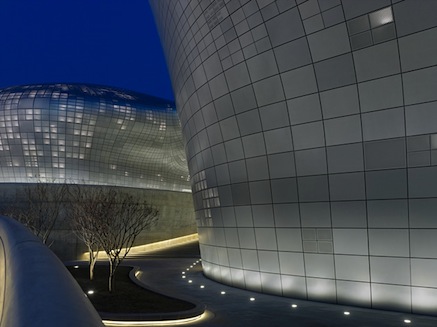
The DDP photos are by Virgile Simon Bertrand.
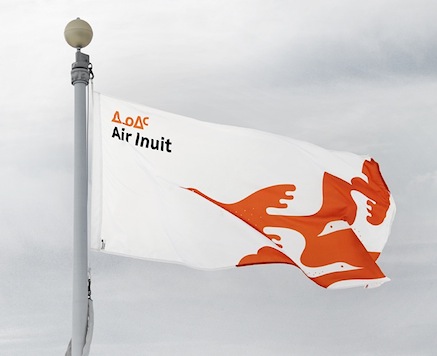
Nunavik, Quebec
Established in 1978 with a lone, single-engine De Havilland Beaver aircraft and collectively owned by the Inuit, who have occupied the territory for thousands of years, Air Inuit is the sole airline providing passenger, charter, cargo, and emergency air transport services to Quebec’s northernmost coastal communities known as Nunavik. Its small fleet of 26 airplanes is well known in the airline industry for having “one of the most enviable safety records in Canada” despite the “challenging and often hostile conditions” under which it operates. The new identity and liverywere designed by Montreal-based FEED in collaboration with brand consultant Marc-André Chaput.
The orange-and-white goose design was created to reflect the Inuit’s love and respect of nature and the abundant wildlife that have allowed its people to survive for thousands of years in one of the planet’s harshest environments. It was also intended to underscore the company’s distinctive corporate culture and bold new vision for the future which includes improving efficiency to cope with rising operating costs, the addition of new routes and specialized services, and a careful expansion into new markets…
Read more and see more of this outstanding re-brand at Brand New, here, where you can also see a “before and after” identity comparison.

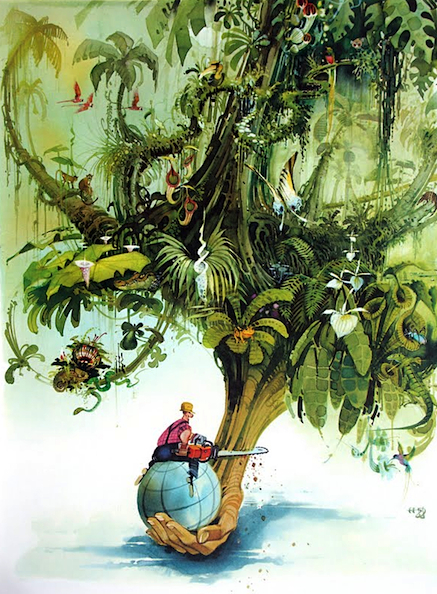
Munich, Germany
Austrian-born Horst Haitzinger is one of Germany’s most prolific political caricature artists, well-known for his robust brushstroke-style as well as his sarcastic irony. The watercolour illustrations shown above are from his 1989 book Globetrottel.
—Jiddu Krishnamurti (1895-1986)
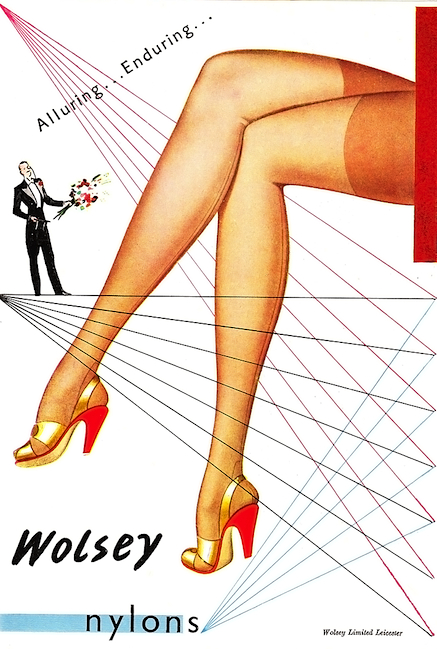
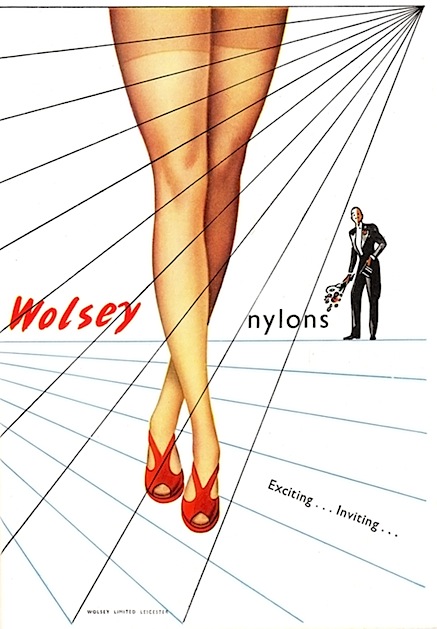
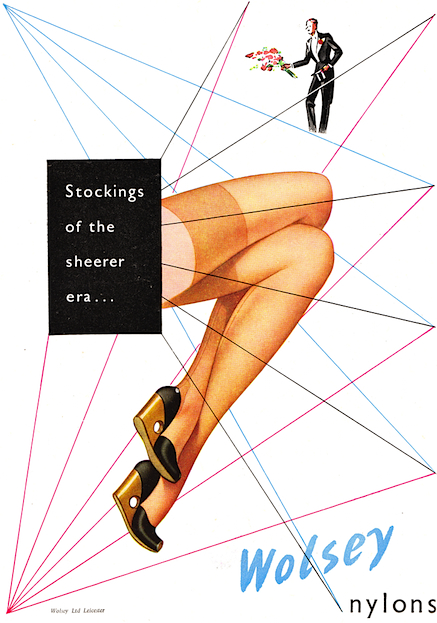
Leicester, UK
Cutting-edge adverts and shapely graphic art feed the seemingly insatiable post-war appetite for fine-denier nylon stockings…